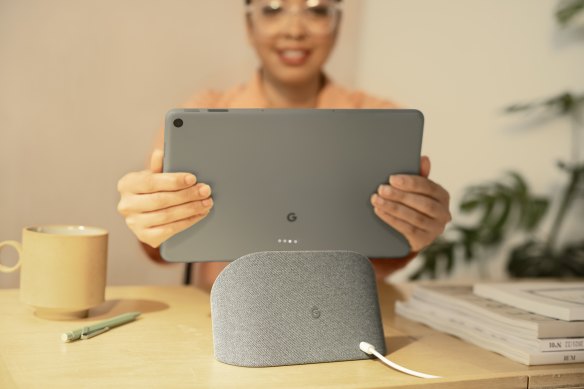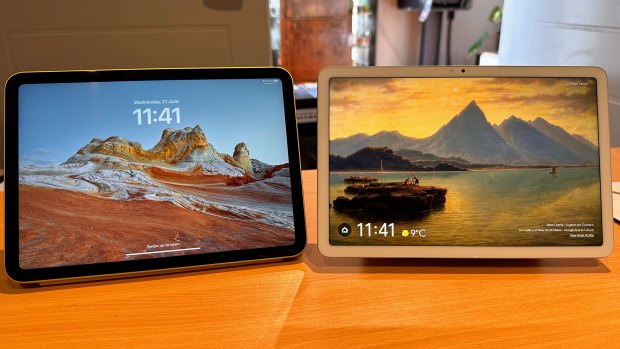
The new Pixel Tablet is as close to an iPad competitor as Google has ever made, expanding its helpful smartphone software to a bigger screen. And it comes with a magnetic charging stand that gives it a lot of utility when not in active use, making it unlike any other tablet on the market. But is that enough to make up for its $900 price tag, when many Android tablets go for half as much?
Before we get to comparisons, this is an interesting and solid tablet in its own right. It packs an 11-inch screen with a Quad-HD resolution, Google’s latest Tensor G2 processor, a pair of HD cameras and 128GB of storage into a device that weighs less than 500 grams. I really like the 16:10 shape of the screen, which is a little better for watching videos than a 4:3 iPad, while many websites work really well in the skinnier portrait orientation.

The Pixel Tablet attaches magentically to its charging dock for use as a smart home hub.
And users of Pixel phones will know how much of a difference software makes. This is the same clean and attractive operating system, which doesn’t come with any bloat and tends to serve you what you’re looking for without much poking around. Most AI-powered camera and editing tricks have made it across from the phones, including Magic Eraser, Face Unblur and Night Sight, even though the front and back shooters here aren’t quite as impressive as on the Pixel 7. You can add multiple profiles to make it an all-family device, and in general, it feels like a big Pixel phone tuned specifically for media consumption.
If you were going to compare this to an iPad it would be the latest standard model, which isn’t a great look for Google since Apple sells that device for $750. It’s similar in size, weight, brightness and sharpness; they even both have fingerprint sensors in the power button. Google’s chip is more modern and its battery life rated a bit higher, plus it has twice the amount of storage. Both Apple and Google offer a 256GB model, and they both charge $1000.
On the other hand, if you compare it to other Android tablets, this one is on the pricey side. Samsung makes a lot of pro-level Android tabs that push into $2000 territory, but for the most part, these devices are $450 or less. They may have a lot less power, inferior screens, weak speakers and a lack of software finesse when compared to the Pixel, but if you’re only using it for web browsing on the couch that might be fine.

The 10th Gen iPad, left, next to the Pixel Tablet in its dock.Credit: Tim Biggs
Setting the Pixel Tablet apart is the included magnetic dock. Tablets tend to get shoved into drawers when not in use, and when you do need them their batteries tend to be dry, so making an ambient tablet part of your smart home is a great idea. Just plug the dock in at your bedside table, kitchen bench or wherever; when you attach the tablet it charges, and any sound is routed through the more powerful speakers, so you can use it as a music machine or little TV. Don’t expect HomePod-like sound though, it’s more like a Nest Mini.
When attached to the dock the tablet functions more or less like a Nest smart display. You can set it to show a range of colourful clocks, images from Google’s art collections, real-time weather animations featuring the adorable Weather Frog, or more boring realistic weather. Alternatively, it makes a great digital photo frame; just select which Google Photos folders you want to pull from and it’s good to go. If you set up shared or automatic folders, that means it could update with new photos of distant family members as soon as they’re taken. The device is pretty good at adapting its brightness and colour to ambient conditions, so it looks like a photo rather than a glowing blue screen.
While docked, there’s also a shortcut button to bring up a smart home panel where you can place your favourite devices and have easy access to speaker volumes, light dimming, heater settings and the like. Or you could just say “Hey Google”. And of course, you can still use it to set timers, check the weather or find any general web information with just your voice, and information will appear on screen as well.



























